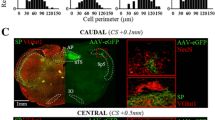Abstract
The projections of superior laryngeal afferents to bulbar neuronal structures were investigated using ortho- and antidromic testing during acute experiments on cats anesthetized with Nembutal. It emerged that endings of the most excitable (group Aβ) afferent fibers were mostly distributed ipsilaterally within the solitary tract nucleus, the adjoining portion of the lateral tegmental field, and the rostral section of the retrofacial nucleus. High threshold (group Aγ and Aδ) afferent fibers also terminate in these nuclei, but are distributed over a wider area than low-threshold afferent projections in the solitary tract nucleus and the lateral tegmental field. The reverse applied to the retrofacial nucleus. Terminals of high threshold (group Aδ) afferents extended to the caudal trigeminal nerve spinal tract nucleus, and possibly to the dorsal motor nucleus of the vagus nerve at obex level.
Similar content being viewed by others
Literature Cited
M. S. Gracheva, Morphology and Functional Role of the Laryngeal Neural Apparatus [in Russian], Medgiz, Moscow (1956).
Yu. E. D'yachenko and N. N. Preobrazhenskii, “Functional differentiation between afferents of the cat superior laryngeal nerve,” Neirofiziologiya,16, No. 5, 777–783 (1984).
B. S. Krylov, R. A. Fel'berbaum, and G. M. Ékimova, Physiology of the Neuromuscular Laryngeal Apparatus [in Russian], Nauka (1984).
V. F. Lashkov, Innervation of the Respiratory Organs [in Russian], Medgiz, Moscow (1963).
B. L. Andrew, “A functional analysis of the myelinated fibers of the superior laryngeal nerve of the rat,” J. Physiol.,133, No. 2, 420–432 (1956).
A. L. Berman, The Brain Stem of the Cat: A Cytoarchitectonic Atlas with Stereotaxic Coordinates, Univ. Wisconsin Press, Madison (1968).
T. J. Biscoe and S. R. Sampson, “Field potentials evoked in the brain stem of the cat by stimulation of the carotid sinus, glossopharyngeal, aortic and superior laryngeal nerves,” J. Physiol.,209, No. 2, 341–358 (1970).
T. J. Biscoe and S. R. Sampson, “Responses of cells in the brain stem of the cat to stimulation of the sinus, glossopharyngeal, aortic and superior laryngeal nerves,” J. Physiol.,209, No. 2, 359–373 (1970).
A. Car, A. Jean, and C. Roman, “A pontine primary relay for ascending projections of the superior laryngeal nerve,” Exp. Brain Res.,22, No. 2, 197–210 (1975).
M. K. Cottle, “Degeneration studies of primary afferents of IXth and Xth cranial nerves in the cat,” J. Comp. Neurol.,122, No. 3, 329–345 (1964).
E. Dunker, D. V. Rehren, and D. Wachsmuth, “The vagovagal reflex arc: some properties of its central part,” Pflügers Arch.,337, No. 3, 199–218 (1972).
Y. Guerrier and M. Hamoir, “Physiologie des nerfs larynges,” Cah. Oto-rhino-laryngol.,17, No. 4, 297–345 (1982).
D. G. Gwen and R. A. Leslie, “A projection of vagus nerve to area subpostrema in the cat,” Brain Res.,161, No. 2, 335–341 (1979).
B. Irani, D. Megirian, and J. H. Sherrey, “An analysis of reflex changes in excitability of phrenic, laryngeal, and intercostal motoneurons,” Exp. Neurol.,36, No. 1, 1–13 (1972).
M. Kalia and M. M. Mesulam, “Brain stem projection of sensory and motor components of the vagus complex in the cat. 2. Laryngeal, tracheobronchial, pulmonary, cardiac and gastrointestinal branches,” J. Comp. Neurol.,193, No. 3, 467–508 (1980).
A. J. Miller and R. F. Loizzi, “Anatomical and functional differentiation of superior laryngeal nerve fibers affecting swallowing and respiration,” Exp. Neurol.,42, No. 2, 369–387 (1974).
R. A. Mitchell and A. J. Berger, “Neural regulation of respiration,” Am. Rev. Respir. Dis.,111, No. 2, 206–224 (1975).
P. Rudomin, “Excitability changes of superior laryngeal, vagal, and depressor afferent terminals produced by stimulation of solitary tract nucleus,” Exp. Brain Res.,6, No. 1, 156–170 (1968).
Additional information
A. A. Bogomolets Institute of Physiology, Academy of Sciences of the Ukrainian SSR, Kiev. Translated from Neirofiziologiya, Vol. 20, No. 1, pp. 81–90, January–February, 1988.
Rights and permissions
About this article
Cite this article
D'yachenko, Y.E. Neurophysiological study of bulbar projections of different groups of superior laryngeal afferents. Neurophysiology 20, 65–72 (1988). https://doi.org/10.1007/BF02198428
Received:
Issue Date:
DOI: https://doi.org/10.1007/BF02198428



